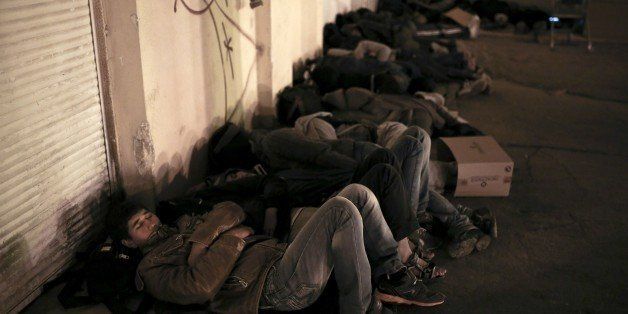
The busy streets in the border state of Coahuila, Mexico are not what they used to be a few years ago. Once populated with orphan children, indigenous women, sad clowns, and teenagers who insist on washing car windows for five Pesos, Coahuila's most trafficked areas are now dominated by new actors who tell a story about innovation in the modern forms of human exploitation. They carry backpacks with water bottles and blankets; they wear caps and have a foreign accent. Despite the existence of shelters and associations, thousands of Central American immigrants are found living and begging on the streets on the northern border states of Mexico, most of them trapped in a nationwide slavery network ran by drug cartels.
In the current immigration debate much is said about the increasing difficulties that undocumented immigrants face due to the recent security measures taken in the Mexico-U.S border, but little attention is devoted to the role that the empowerment of Mexican drug cartels has played in reshaping the human smuggling dynamics in the last years. Until 2009, at least 47 independent cartels dedicated to human smuggling and human trafficking operated in Mexico. However, with the emergence of Los Zetas as an independent cartel in 2010 and the empowerment of the Cartel Del Golfo (CDG) in the last five years, the smaller cartels have been absorbed or destroyed, producing a dramatic change in the dynamics of human trafficking and human smuggling in the country.
Mexican drug cartels have identified a lucrative niche of opportunity in the geostrategic position of Mexico as "bridge country" for migration flows towards the U.S., and are now actively exploiting it. These organizations have vigorously seized the human smuggling activities in the southern and northern borders of Mexico, and have transformed them into diverse forms of trafficking and exploitation. Every year thousands of Central Americans fall prey to drug cartels while crossing the southern border of Mexico. The victims are frequently extorted, assaulted, and trafficked for forced labor and sexual exploitation within the country and in the United States. Some of the immigrants are forced to beg for money on the streets, while others are found in this position after being extorted and deprived from their resources to cross the border. In this dramatic scenario, the increase in trafficking of immigrant children who are captured by the cartels for sexual exploitation, forced labor or used as child soldiers in the drug wars in the country becomes particularly worrisome.
The increasing participation of drug cartels in human trafficking has been made possible not only by their capabilities and resources, but by the widespread lack of law enforcement, the prevailing corruption, and the absence of adequate mechanisms to prevent and address human trafficking in Mexico. Before 2007, Mexico did not have any Anti-trafficking laws and, therefore, no appropriate programs or formal funds devoted to this issue. In particular, the southern border has become a lawless territory where drug cartels operate freely and with impunity, harassing the few NGO's remaining and threatening the local authorities. In this context, the growing control of cartels over human trafficking is expected to generate an increase in the frequency, reach, and impact of this criminal activity in Mexico in the next decade. In this scenario, undocumented Central American immigrants become increasingly vulnerable targets.
As drug cartels gain the power, the resources, and the capabilities to exploit a larger pool of victims in Mexico for trafficking purposes, the social fabric of the country become increasingly threatened. The monopoly of trafficking activities in Mexico will allow cartels to harass and exploit entire regions generating grave, long-term social problems such as a dramatic increase in violence, the seizure of power over entire states and regions by cartels, the spread of AIDS, the rupture of thousands of families, and the perpetuation of violence against women, indigenous communities, and Central Americans. In this context, Mexico, the fifth largest source of human trafficking in Latin America, is likely to become the leader in this illicit activity in the next decade while solidifying its first place as producer and distributor of child pornography and sex tourism in the world.
Furthermore, it is important to note that by controlling the two largest and most lucrative illegal activities in Mexico, drug cartels are generating a massive erosion of the State from within. As these organizations take over the activities of human trafficking, they implement more resources to corrupt the authorities, infiltrate institutions, and weaken law enforcement. This produces a vicious cycle where "corruption facilitates the operation of Mexico's vast and powerful criminal-business enterprises while simultaneously debilitating the State's efforts to confront them", as noted by Stephen D. Morris.
Every year, less immigrants achieve their goal of being smuggled into the U.S as they more often fall prey of the growing network of exploitation ran by drug cartels in Mexico. The decrease in undocumented immigrants trying to cross the border should not be assumed as a triumph of security policies, but further analyzed as a comprehensive phenomenon that is nourishing a growing threat to the stability of both Mexico and the United States: drug cartels.